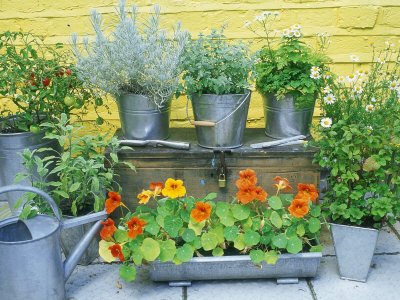Recipe of the Day Categories:
 Recipe Home
Recipe Home
 Recipe Index
Recipe Index
 Appetizers
Appetizers
 Beef
Beef
 Beverage
Beverage
 Bread
Bread
 Breakfast
Breakfast
 Cake
Cake
 Chocolate
Chocolate
 Cookies
Cookies
 Fish Fish
 Fruit Fruit
 Main Dish
Main Dish
 Pasta
Pasta
 Pies
Pies
 Pork
Pork
 Poultry
Poultry
 Salad
Salad
 Seafood
Seafood
 Side Dish
Side Dish
 Soup
Soup
 Vegetable
Vegetable
 Surprise! Surprise!


Parsley
Giclee Print
Thacker, Kate...
Buy at AllPosters.com
 

Tropaeolum "Tutti Frutti"
Photographic Print
Bolton, Mark
Buy at AllPosters.com

Sunflowers, Lemon, and Orange
Giclee Print
Ochoa, Isy
Buy at AllPosters.com

Shop igourmet.com
|
|
Your
patronage of our affiliate
partners supports this web site.
We thank you! In other words, please shop at LBC
Gift Galerie!

Herbs in Metal Pots Curry Plant, Catmint, Feverfew, Chamomile,
Eau de Cologne Mint, Yellow Sage
Photographic Print
Lord, Andrew
Buy at AllPosters.com

La Belle Cuisine
Salsa Verde

Zuni Cafe
Cookbook
By Judy Rodgers, © 2002,
published by W.W. Norton & Co.,
Inc.
“Salsas, especially green ones, are great democratizers in the kitchen.
Anyone
can make an excellent one, they go with humble as well as fancy
dishes, they
are crowd pleasers, and they need not be expensive. They are
not, of course,
forgiving
of mediocre ingredients, so make the effort to
gather perky, fragrant,
herbs. Chop
them only just before you assemble the salsa – and don’t do that
too far in
advance. Time will dull the bright taste and texture.
Guidelines regarding the herbs and preparing them:
-
Choose herbs as you would flowers – go for pretty and fragrant, avoid
wilted and bruised. Pick off the leaves, culling any yellowed ones that
may have snuck into your pristine bouquet. When using parsley, chervil,
and cilantro, I include some of the slender, tender terminal stem – it
usually tastes sweet and adds another texture to the salsa. Try this.
-
Wash and dry the herbs carefully. A little grit will spoil a salsa, and
water will make it dull. I spin the leaves in a salad spinner with a dry
paper towel to absorb hidden water.
-
Chop the herbs with a very sharp knife. A dull knife smashes as much as it
chops, extracting the green juice from the herbs. This juice oxidizes
rapidly and can give the salsa a tired flavor. (Or it stays on the cutting
board. You want it to stay in the leaves.)
-
Don’t chop the herbs too fine. Most cooks enjoy the smell as they chop
herbs, but I spoil that pleasure if they are being too thorough, reminding
them that all that scent is gone now, not to be captured in any salsa, or
other dish. The finer you chop, the fewer remaining intact cells full of
scent you save for your guests. Chop the herbs into little flakes just
small enough to produce a pleasant texture.
-
Likewise, don’t chop the herbs too evenly. Leave some flakes slightly
larger than others; they will give the salsa a pretty look, but more
important, the bigger flakes explode with flavor when you bite through
them. If combining different herbs in one salsa, try leaving one type
fairly coarse – it won’t shed as much flavor into the oil, but it will
make up for it later. This makes a salsa multilayered, and fun to eat.
-
Don’t chop the herbs in advance, or add leftover chopped herbs to a salsa.
Once you’ve chopped the herbs, trap their fragrance in the oil as soon as
possible.
Regarding the rest of the ingredients:
Most of our green salsas are bound with olive oil and usually include
capers,
or something briny, like chopped glasswort; someone from the onion
family;
citrus
zest; and cracked pepper or crushed chili.
It doesn’t usually make sense to use your most precious extra-virgin olive
oil
here, as the collision of aromatics may overwhelm it, but do us
delicious oil –
it will be noticed. As you decide how much oil to add to a
salsa, take into consideration the dish it is going with – is it dry or wet,
lean or succulent?
Grilled fish with lean white beans will tolerate a
well-lubricated salsa, but a
rib-eye steak needs very little extra fat, just
enough oil to bind the herbs.
Likewise, boiled green beans or grilled
zucchini are good with a rich salsa,
but grilled eggplant wants little extra
oil.
Use the same kind of reasoning to decide whether to add body-building
ingredients to salsas – chopped hard-cooked egg, mustard, avocado, nuts,
and
finely diced ripe tomato (or other ripe fruits) all make a salsa fleshier
or
at least thicker, but each
in a different way. Consider the flavors and
richness of the dish before you choose
to enrich a salsa this way. Mustard
will give spark and muscle to a salsa destined
for a wintry Pot-au-Feu
[recipe included in cookbook] or a robust steak, while chopped egg or
avocado will flatter quiet salmon, bass, or chicken dishes, and so
on.
That
said, don’t clutter the salsa with too many supplemental flavors.”
Salsa Verde with Parsley &
One Other Pungent Herb
“This is a basic formula you may never make
the same way twice.”
For 1 to 1
1/4 cups:
1/2 cup tightly packed chopped
fresh flat-leaf parsley
(nearly
1 cup loosely packed)
2 to 3 tablespoons tightly packed
chopped other herb, such as fresh
tarragon, chervil, chives, cilantro,
mint, watercress, spicy broadleaf
cress, garden cress, nasturtium
blossoms, small nasturtium leaves,
or basil
–
green or purple,
and consider lemon- or
cinnamon-scented basil as well
1 tablespoon capers, rinsed,
pressed dry between towels,
and coarsely
chopped, or
1 tablespoon chopped glasswort,
fresh or pickled
About 2 teaspoons finely chopped lemon
zest (from 2 small lemons), or
a
combination of lemon and orange zest
1 tablespoon finely diced shallot or
red onion or thinly sliced scallion
Salt
Freshly cracked black pepper or
dried chili flakes, crushed
1/2 to 3/4 cup extra-virgin olive oil
(a part of this could be lemon oil…)
Optional
ingredients to add body, tooth,
and character to the salsa:
1 to 1 1/2 teaspoons Dijon mustard
1/2 hard-cooked egg, chopped,
or 1/4 just-ripe medium avocado,
neatly diced
1 tablespoon chopped walnuts or
pine nuts
1 teaspoon rinsed, chopped Preserved
Lemon and Limequat
[recipes in cookbook]
1 teaspoon chopped salt-packed
anchovies (about 2 fillets)
Combine the parsley, other herb, capers, zest, shallot or
red onion or
scallion, a few pinches of salt, pepper or chili flakes to
taste, and barely
1/2 of the olive oil. Stir and taste. Add more oil and
salt to taste; since
salt will not dissolve instantly in the olive oil,
allow each sprinkle time
to dissolve before you decide the salsa needs
more. Stir in any optional
ingredients and transfer to a tall storage
vessel, so very little of the salsa
is exposed to the air. Don’t
refrigerate, but set in a cool spot until
needed. Do refrigerate
leftovers.
Celery Leaf Salsa Verde
“Every kitchen I have worked in has a discreet stash of unloved pale,
leafy celery hearts. So pretty, but their flavor is not popular raw. They
are unwelcome in
stocks and uninteresting in sautéed dishes. I do like
the
tiniest ones deep-fried…
but confronted with a constant glut, we
devised
this salsa, which transforms their brash flavor into an exciting,
peppery
condiment. It is good with grilled chicken breast, roast pork,
or grilled or
broiled fish and smeared on Carpaccio."
For about
1 cup:
2 tablespoons tightly packed chopped
fresh flat-leaf parsley
1/4 cup tightly packed chopped
celery leaves
2 tablespoons finely diced tender, pale
yellow inner celery stalks
2 tablespoons capers, rinsed,
pressed dry between towels,
and coarsely chopped
1 lemon (to yield about 1 teaspoon
chopped zest plus juice to taste)
1 teaspoon finely diced jalapeño,
preferably red
1 tablespoon finely diced red onion
1 teaspoon chopped salt-packed anchovies
(about 2 fillets) (optional)
About 1/2 cup extra-virgin olive oil
Salt and freshly cracked black
pepper to taste
Combine all the ingredients, adjusting any to your taste.
Allow the salt
time
to dissolve before adding more. Don’t refrigerate, but set in a
cool spot
until ready to use. Stir occasionally to encourage the flavors
to mingle.
Refrigerate leftovers.
Featured Archive Recipes:
Fruit Salsas
Salsa Collection
Salsa Verde (Mario
Batali)
Index - Condiment Recipes
Index - Appetizer Recipes
Index - Cinco de Mayo Recipes
Daily Recipe Index
Recipe Archives Index
Recipe Search
|









